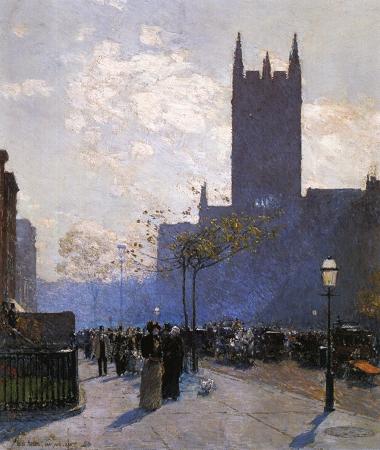Union Square. Union Square is a historic intersection and surrounding neighborhood in Manhattan, New York City, located where Broadway and the former Bowery Road-now Fourth Avenue-came together in the early 19th century; its name denotes that here was the union of the two principal thoroughfares of the island. The current Union Square Park is bounded by 14th Street on the south, Union Square West on the west side, 17th Street on the north, and on the east Union Square East, which links together Broadway and Park Avenue South to Fourth Avenue and the continuation of Broadway. The park is under the aegis of the New York City Department of Parks and Recreation. Adjacent neighborhoods are the Flatiron District to the north, Chelsea to the west, Greenwich Village to the southwest, East Village to the southeast, and Gramercy Park to the east. Many buildings of The New School are near the square, as are several dormitories of New York University. The eastern side of the square is dominated by the four Zeckendorf Towers, the Consolidated Edison Building, on the former site of the bargain-priced department store, S. Klein, and the south side by the full-square block mixed-use One Union Square South. It features a kinetic wall sculpture and digital clock expelling bursts of steam, titled Metronome. Among the heterogeneous assortment of buildings along the west side is the Decker Building. Union Square is noted for its impressive equestrian statue of U.S. President George Washington, modeled by Henry Kirke Brown and unveiled in 1856, the first public sculpture erected in New York City since the equestrian statue of George III in 1770, and the first American equestrian sculpture cast in bronze; the historic moment depicted is Evacuation Day, November 25, 1783, when the British left the city and General Washington triumphantly led his troops back into the city. Other statues in the park include the Marquis de Lafayette, modeled by Frederic Auguste Bartholdi and dedicated at the Centennial, July 4, 1876, the statue of Abraham Lincoln, modeled by Henry Kirke Brown, and the James Fountain, a Temperance fountain with the figure of Charity who empties her jug of water, aided by a child; it was donated by Daniel Willis James and sculpted by Adolf Donndorf. A statue of Mahatma Gandhi in the southwest corner of the park was added in 1986. At the time that John Randel was surveying the island in preparation for the Commissioners' Plan of 1811, the Bloomingdale Road angled away from the Bowery at an acute angle that would have been so awkward to build on, that the Commissioners decided to form a square at the union. In 1815, by act of the state legislature, this former potter's field became a public commons for the city, at first named Union Place. In 1832, at a time when the space was surrounded by empty lots, Samuel Ruggles, one of the founders of the Bank of Commerce and the developer of Gramercy Park to the northeast, convinced the city to rename the area as Union Square and enlarge the commons to 17th Street on the north and extend the axis of University Place to form the square's west side. Ruggles obtained a fifty-year lease on most of the surrounding lots from 15th to 19th Streets, where he built sidewalks and curbs. In 1834, he convinced the Board of Aldermen to enclose and grade the square, then sold most of his leases and in 1839 built a four-storey house facing the east side of the Square.
more...





